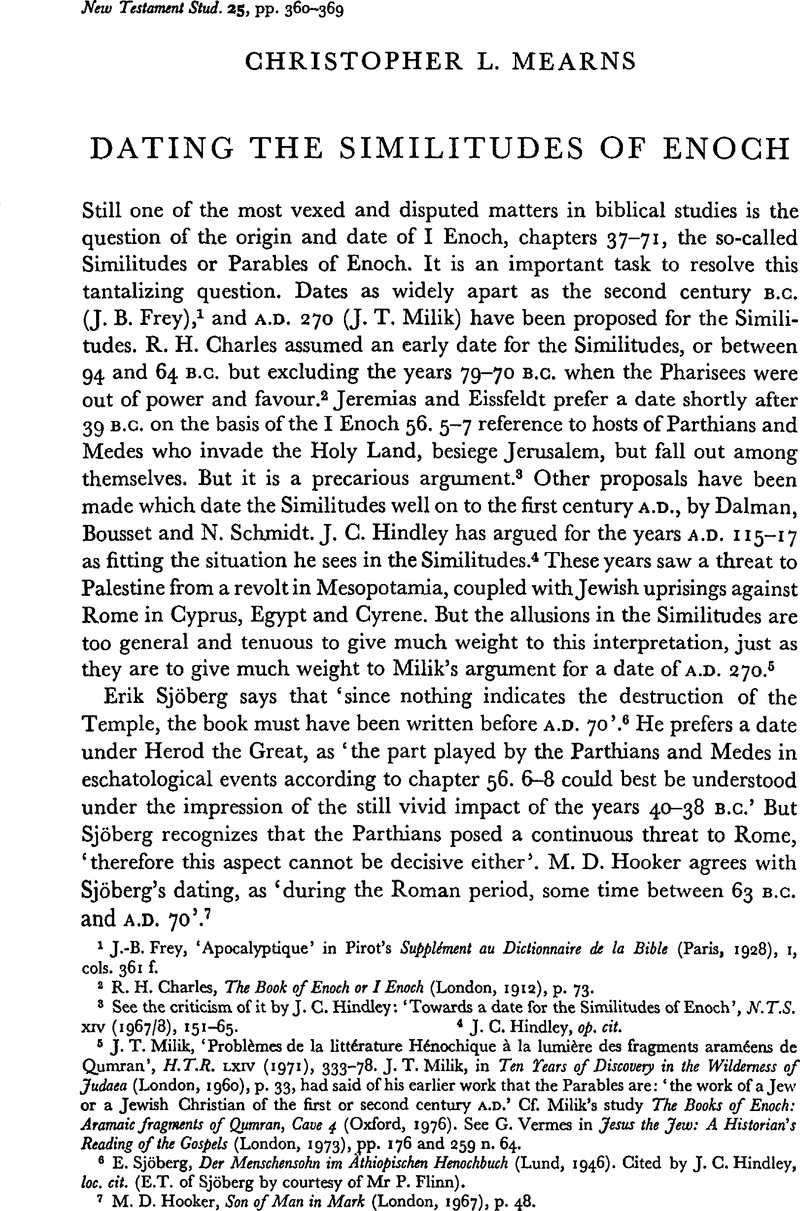Article contents
Dating the Similitudes of Enoch
Published online by Cambridge University Press: 05 February 2009
Abstract

- Type
- Seminar Report
- Information
- Copyright
- Copyright © Cambridge University Press 1979
References
1 Frey, J.-B., ‘Apocalyptique’ in Pirot's Supplément au Dictionnaire de la Bible (Paris, 1928), 1,Google Scholar cols. 361 f.
2 Charles, R. H., The Book of Enoch or I Enoch (London, 1912), p. 73.Google Scholar
3 See the criticism of it by Hindley, J. C.: ‘Towards a date for the Similitudes of Enoch’, N.T.S. 14 (1967/1968), 151–65.Google Scholar
4 J. C. Hindley, op. cit.
5 Milik, J. T., ‘Problèmes de la littérature Hénochique à la lumière des fragments araméens de Qumran’, H.T.R. 64 (1971), 333–78.Google ScholarMilik, J. T., in Ten Years of Discovery in the Wilderness of Judaea (London, 1960), p. 33Google Scholar, had said of his earlier work that the Parables are: ‘the work of a Jew or a Jewish Christian of the first or second century A.D.’ Cf. Milik's, study The Books of Enoch: Aramaic fragments of Qumran, Cave 4 (Oxford, 1976)Google Scholar. See Vermes, G. in Jesus the Jew: A Historian's Reading of the Gospels (London, 1973), pp. 176 and 259 n. 64.Google Scholar
6 Sjöberg, E., Der Menschensohn im Athiopischen Henochbuch (Lund, 1946)Google Scholar. Cited by J. C. Hindley, loc. cit. (E.T. of Sjöberg by courtesy of Mr P. Flinn).
7 Hooker, M. D., Son of Man in Mark (London, 1967), p. 48.CrossRefGoogle Scholar
8 See reconstruction from Manichaean passages in Henning, W. B., ‘The Book of Giants’ in Bulletin of Oriental and African Studies 11 (1943–1946), 52–74.CrossRefGoogle Scholar
9 Milik, admits this. The Books of Enoch (Oxford, 1976), section on the Similitudes.Google Scholar
10 Delcor, M., Le Testament d'Abraham (Leiden, 1973).Google Scholar
11 Box, G. H., The Testament of Abraham (London, 1927), introduction, p. xxviiiGoogle Scholar. M. R. James' attribution to a Christian writer of the second century A.D. is eccentric. Köhler, , J.Q.R. 7 (1895), 581 ff.Google Scholar, argued for a first century A.D. date.
12 Fishburne, C. W., ‘I Cor. 3. 10–15 and the Testament of Abraham’, N.T.S. 17 (1970–1971) 109–15.Google Scholar
13 For the text of the Greek recensions: Stone, M. E., The Testament of Abraham: The Greek Recensions, S.B.L. (University of Montana, 1972), Texts and Translations 2, Pseudepigrapha Series 2.Google Scholar
14 M. Delcor agrees with N. Turner who in an unpublished Ph.D. thesis for London University, 1953, upheld an anterior date for the shorter text, and also with F. Schmidt, in a University of Strasbourg thesis, 1971, who argued that the long text is a reworking of the shorter text. See Schmidt, F., Le Testament d'Abraham: introduction, édition de la recension courte, traduction et notes.Google Scholar
15 For further material on Test. Ab., see the forthcoming contribution by Enno Janssen in Judische Schriften aus hellenistischrömischer Zeit (Hg. W. G. Kümmel u.a.).
16 Burkitt, F. C., Jewish and Christian Apocalypses (Schweich Lectures for 1913) (London, 1914), p. 23.Google Scholar
17 F. C. Burkitt, op. cit. p. 23.
18 Hamerton-Kelly, R. G., Pre-Existence, Wisdom and the Son of Man, Society for New Testament Studies Monograph 21 (Cambridge, 1973), p. 83.CrossRefGoogle Scholar
19 See Schulz, S., Untersuchungen zur Menschensohn-Christologie im Johannes-evangelium (Göttingen, 1957), pp. 109–22Google Scholar. Cited by Hamerton-Kelly, op. cit. p. 235.
20 Robinson, J. A. T., Redating the New Testament (London, 1976), pp. 239–40 n. 98Google Scholar. Robinson cites Edmondson, G., The Church in Rome in the First Century (London, 1914), p. 169Google Scholar, for the catastrophic events at both Rome and Jerusalem in the years A.D. 68–70 as forming the most likely occasions for the apocalyptic fervour giving rise to Revelation.
21 Black, M., ‘The Son of Man problem in recent research and debate’, B.J.R.L. 45 (1962–1963), 217.Google Scholar
22 Lindars, B., ‘The Apocalyptic myth and the death of Christ’, B.J.R.L. 57 (1975), 380.Google Scholar
23 Baeck, L., ‘The Faith of Paul’, Journal of Jewish Studies, 3, no. 3 (1952), 93 ffCrossRefGoogle Scholar. (The present writer is indebted to Professor F. F. Bruce for reference to this.) Scholem, Gershom, The Messianic Idea in Judaism (New York, 1971)) esp. p. 20Google Scholar. See also Schweitzer, A., The Mysticism of Paul the Apostle (London, 1931), p. 193Google Scholar, and The Kingdom of God and Primitive Christianity (London, 1968), p. 157Google Scholar; Davies, W. D., Torah in the Messianic Age or Age to Come, J.B.L. Monograph Series vii (Philadelphia, 1952)Google Scholar, section: ‘Passages from rabbis indicating an abrogation or considerable change in Torah in the messianic age or age to come’; Käsemann, E., ‘On the topic of primitive Christian apocalyptic’, Journal for Theology and the Church, 6, Apocalypticism (New York, 1969), 118 ff.Google Scholar; Bartsch, H. W., ‘Early Christian Eschatology in the Synoptic Gospels’, N.T.S. 11, 387–97Google Scholar; Lane, W. L., ‘I Tim. 4. 1–3, An instance of over-realized eschatology?’, N.T.S. 11 (1964–1965), 164–7Google Scholar; Wilckens, U., Dogma und Denkstrukturen, ed. Joest, W., and Pannenberg, W. (1963), pp. 58–9Google Scholar, cited by Schmithals, W., Paul and the Gnostics, E. T. by J. E.Seely (Abingdon, N.Y. 1972), p. 163 n. 140Google Scholar. The present writer's work in the area of Pauline eschatology seeks to establish that evidence is provided particularly by the Thessalonian and Corinthian epistles, which enables us to trace and reconstruct the process by which Paul introduced and commended the development of the new distinctively futurist eschatology.
- 6
- Cited by




